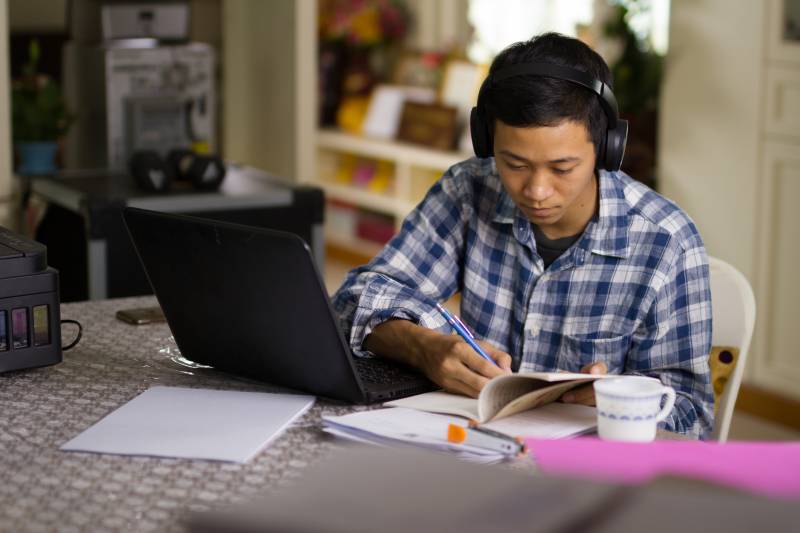“I have seen much improved reading skills, more applied reading skills, going back and rereading text, identifying those words that they don’t know,” Bradley said. “That dynamic of writing it down, thinking about it, having the opportunity to think about it very clearly and easily together in this session without having to navigate to multiple other tabs – yeah, it’s been really good.”
While Bradley appreciated the ability to introduce her students to new types of technology or improve their technological skills, she also wanted to be cognizant of the potentially overwhelming effect of near-ceaseless technology on her students with less technological backgrounds. The comfort and cultural familiarity of paper for newcomers also played a role in her decision to encourage paper notes.
“It is a way for them if they are just learning that technology to feel competent and to feel good before transitioning to a computer, or just as an alternative way of showing what they know that’s more appropriate for them as learners,” Bradley said.
Applying culturally competent techniques when teaching virtually is a priority for Efraín Tovar, an English Language Development (ELD) teacher in Selma, California. Tovar works specifically with newcomers — at his school, that’s students who have spent three years or less in the United States. His students predominantly speak Spanish, Punjabi or Arabic as their first language.
During virtual learning, Tovar taught his students how to enable closed captioning on Google Meet, as well as how to translate those captions into a student’s primary language, with Google Meet providing instantaneous translation in more than 100 languages.
“Closed captions in itself helps all students, regardless if they’re English language learners or not, because some students are visual learners,” said Tovar. “It’s definitely an accessibility feature that everyone can benefit from.”
Tovar instructs the teachers at his school to decrease their rates of speech and use standard or academic English. These techniques improve the accuracy of the captioning and its translation. He teaches the students he works with how to turn on the service: as a user-based, rather than teacher-based, function, students need to enable it on their own. This, Tovar said, encourages students to take agency in their learning.
This agency also comes into play with Immersive Reader, a tool on Microsoft devices with similar browser extensions. It offers the ability to read entire articles out loud, to translate them to multiple languages and to hear each language read with natural inflections. Students can select individual words and find their definitions, translations and parts of speech. They can also hear words read aloud to learn their pronunciations, and attempt to pronounce the words on their own to receive feedback on accuracy.
While some students learning English might be reticent to ask how to pronounce or read a word in a classroom setting, the discreteness and privacy of this extension allows them to practice the word on their own and grants them the security of knowing the word before reading it aloud in class.
“That has empowered students to take ownership of their own learning as they become better readers,” Tovar said.
Pronunciation also comes into play with the self-publishing ebook program Tovar’s students use, Book Creator. They create ebooks in both their native language and English. While he began using this program prior to March 2020, he believes that the creativity required by the project was crucial for engaging students during virtual education.
“It’s an effective way that I have seen this year to get kids to become creators of content rather than just consumers of ELD worksheets, or worksheets in general,” Tovar said.
Students describe topics ranging from a provided picture to their personal career goals. A sample book might include a line in a primary tongue, followed by the same line in English, with audio narration accompaniment in both languages. Students who are unable to write in their native tongues can use a speech-to-text function. The project allows students to continue practicing their native language, important for validating students’ histories, cultures and home languages development.
“Language is tied to identity,” Tovar said.
Tovar’s school, Abraham Lincoln Middle, began using the translation tool within Parent Square during the COVID-19 pandemic. With this, all parents are able to reach out to their children’s teachers via cell — in their primary languages. Parent Square translates this message to English for teachers, whose responses are then translated to the parent’s predominant language.
A Pew Research study from 2019 found that Latinx and Black adults in the U.S. are more likely to have smartphones than traditional computers or broadband internet at home than white adults. By allowing parents to utilize tools that they have, schools can ensure that language and digital divides don’t prohibit parents from taking active roles in their children’s education.
Parent Square’s translate-texting function not only enables a cross-language two-way conversation, it might be more accessible for parents who are essential workers. When students don’t log in to virtual classes, Parent Square allows teachers to quickly text parents to notify them of an absence. This way, whether or not they’re at home, parents are able to hold their children accountable for showing up to online classes.
“I hope we don’t go back. I hope the way we teach is different moving forward,” Tovar said. “Every single teacher, I would say, in the United States has beefed up their tech tools. And I think they realized that teachers can be creative as well, that technology is not a scary thing and that they can actually incorporate technology into their teaching.”


